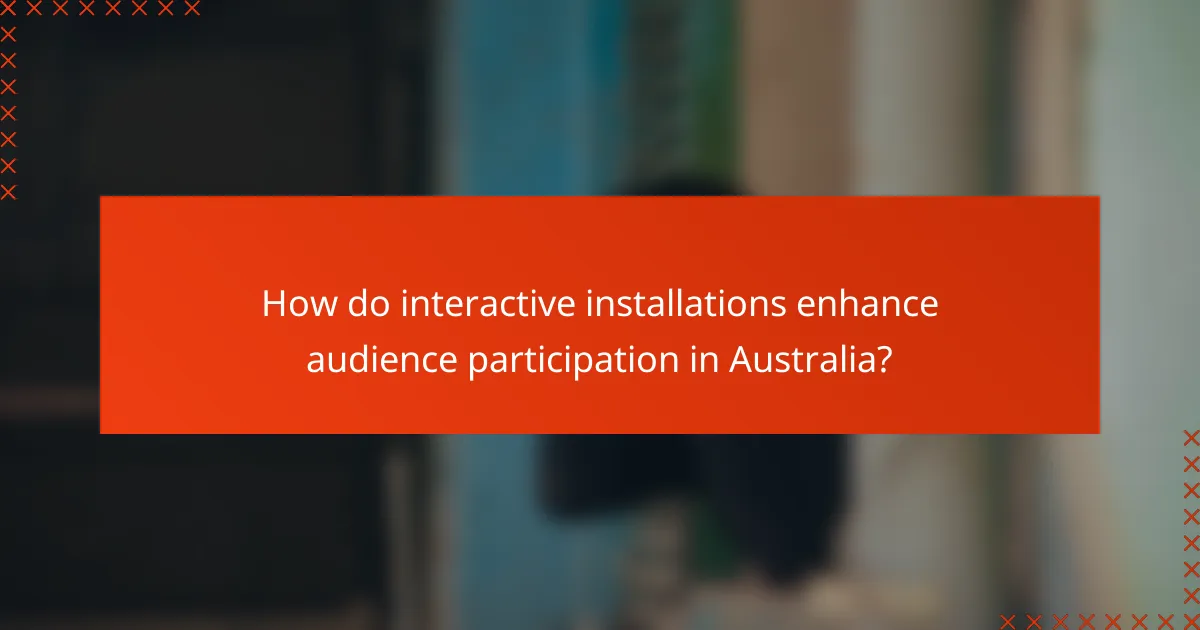Interactive installations serve as a powerful medium for audience participation, transforming passive observers into active participants within engaging environments. By merging technology and art, these installations not only enhance experiential learning but also promote creative expression, enabling individuals to explore their creativity collaboratively and dynamically.

How do interactive installations enhance audience participation in Australia?
Interactive installations in Australia significantly boost audience participation by creating engaging environments that invite individuals to actively partake in the experience. These installations often blend technology and art, fostering a sense of community and personal connection among participants.
Engagement through immersive experiences
Immersive experiences draw participants into a narrative or environment, making them feel like active contributors rather than passive observers. For instance, installations that utilize virtual reality or augmented reality can transport individuals to different settings, allowing them to interact with the artwork in unique ways. This level of engagement can lead to deeper emotional connections and memorable experiences.
In Australia, many galleries and public spaces are incorporating these immersive elements to attract diverse audiences, ranging from families to art enthusiasts. The use of sensory stimuli, such as sound and light, enhances the overall experience, making it more captivating.
Collaborative art projects
Collaborative art projects encourage audience participation by inviting individuals to contribute their creativity to a shared work. These projects can take various forms, such as community murals or interactive sculptures, where participants can add their personal touches. This not only fosters a sense of ownership but also builds community ties as people work together towards a common goal.
In Australian cities, initiatives like public art festivals often feature collaborative installations, allowing locals to engage with artists and each other. This interaction can spark new ideas and inspire further artistic expression within the community.
Real-time feedback mechanisms
Real-time feedback mechanisms in interactive installations allow participants to see the immediate impact of their actions, enhancing engagement. For example, installations that respond to touch or movement can create a dynamic experience where users can influence the artwork directly. This instant feedback loop encourages exploration and experimentation, making the experience more rewarding.
In Australia, many interactive exhibits in museums and science centers utilize these mechanisms to educate visitors while keeping them entertained. By providing instant responses, these installations can effectively convey complex concepts in an accessible and enjoyable manner.

What are the benefits of experiential learning in interactive installations?
Experiential learning in interactive installations offers numerous benefits, including increased engagement, practical skill development, and deeper understanding of concepts. By allowing participants to actively engage with the material, these installations foster a dynamic learning environment that enhances the overall educational experience.
Hands-on learning opportunities
Interactive installations provide hands-on learning opportunities that encourage participants to explore and experiment. This active involvement helps to bridge the gap between theory and practice, making complex ideas more accessible. For instance, a science exhibit that allows users to conduct simple experiments can significantly enhance comprehension.
To maximize hands-on learning, installations should be designed with clear instructions and accessible materials. This ensures that participants can easily engage with the content without feeling overwhelmed or confused.
Enhanced retention of information
Experiential learning through interactive installations can lead to enhanced retention of information. Engaging multiple senses during the learning process helps solidify knowledge in participants’ minds. For example, a history installation that combines visual displays with tactile elements can create a memorable experience that participants are more likely to recall later.
To further improve retention, consider incorporating storytelling elements or real-life applications of the information. This contextualization makes the learning experience more relatable and memorable for participants.
Development of critical thinking skills
Interactive installations foster the development of critical thinking skills by encouraging participants to analyze, evaluate, and create. Engaging with complex problems in a hands-on environment promotes deeper cognitive processing. For instance, a design challenge within an installation can prompt users to brainstorm solutions, fostering innovative thinking.
To effectively cultivate critical thinking, installations should present open-ended questions and scenarios that invite exploration. This approach encourages participants to think independently and develop their problem-solving abilities.

How do interactive installations promote creative expression?
Interactive installations foster creative expression by engaging audiences in immersive experiences that encourage participation and collaboration. These installations often blend art and technology, allowing individuals to explore their creativity in unique and dynamic ways.
Platforms for artistic collaboration
Interactive installations serve as platforms where artists and audiences can collaborate, creating a shared artistic experience. This collaboration can take many forms, such as community art projects or workshops where participants contribute their ideas and skills.
For instance, a public mural project may invite local residents to paint sections of the wall, resulting in a collective artwork that reflects the community’s identity. Such collaborative efforts not only enhance creative expression but also strengthen community bonds.
Encouragement of personal storytelling
These installations often encourage personal storytelling by inviting participants to share their experiences and narratives. By providing tools or prompts, interactive art can transform individual stories into collective experiences, making the art more relatable and impactful.
For example, an installation might feature a digital wall where visitors can write or record their stories, which are then projected for others to see. This approach not only promotes creativity but also fosters empathy and understanding among participants.
Integration of technology and art
The integration of technology in interactive installations enhances creative expression by providing new mediums and tools for artists and participants. Technologies such as augmented reality, virtual reality, and interactive sensors can transform traditional art forms into engaging, multi-dimensional experiences.
For instance, an installation might use motion sensors to allow visitors to manipulate digital elements with their movements, creating a personalized art experience. This combination of technology and art opens up endless possibilities for creative exploration and innovation.

What are the key components of successful interactive installations?
Successful interactive installations hinge on user engagement, accessibility, and sensory integration. These components work together to create immersive experiences that foster audience participation and enhance creative expression.
User-friendly design
User-friendly design is crucial for ensuring that participants can easily navigate and engage with the installation. Clear instructions, intuitive interfaces, and visually appealing layouts help attract and retain audience attention. For example, using simple touchscreens or gesture-based controls can enhance interaction without overwhelming users.
Consider conducting usability testing with a diverse group to identify potential barriers. Aim for designs that require minimal prior knowledge, allowing users to engage quickly and effectively.
Accessibility for diverse audiences
Accessibility is vital for reaching a broad audience, including individuals with disabilities. Incorporating features like audio descriptions, tactile elements, and adjustable settings can make installations more inclusive. For instance, providing sign language interpretation or braille labels can enhance the experience for those with hearing or visual impairments.
Adhering to established accessibility standards, such as the Web Content Accessibility Guidelines (WCAG), can guide the design process. Regular feedback from diverse user groups can help identify areas for improvement and ensure that the installation meets a wide range of needs.
Integration of sensory elements
Integrating sensory elements—such as sound, light, and touch—can significantly enhance the immersive quality of an installation. These elements can evoke emotions and create memorable experiences, encouraging deeper audience participation. For example, using ambient sounds or interactive lighting can draw users into the environment and stimulate their curiosity.
When designing sensory experiences, consider the balance between stimulation and overwhelm. Aim for a harmonious blend that captivates without distracting, allowing participants to focus on the interactive aspects of the installation. Regular testing with real users can help fine-tune these sensory integrations for optimal engagement.

What criteria should be considered when selecting interactive installations?
When selecting interactive installations, consider factors such as target audience demographics, space and location requirements, and budget constraints. These criteria will help ensure the installation is engaging, feasible, and financially viable.
Target audience demographics
Understanding the target audience demographics is crucial for designing an effective interactive installation. Consider age, interests, and cultural background, as these factors influence how participants engage with the installation. For instance, installations aimed at children may incorporate more playful elements, while those for adults might focus on complex themes.
Gathering data through surveys or community feedback can provide insights into the preferences and expectations of your audience. Tailoring the experience to these demographics can enhance participation and satisfaction.
Space and location requirements
Space and location are vital for the success of interactive installations. Assess the physical dimensions and layout of the venue to ensure it can accommodate the installation comfortably. Consider factors like foot traffic, visibility, and accessibility, as these will impact audience engagement.
For example, outdoor installations may require considerations for weather conditions and public safety, while indoor installations might need to adhere to specific building codes. Always plan for adequate space for participants to interact without feeling cramped.
Budget and funding sources
Budget constraints play a significant role in the selection of interactive installations. Determine the total cost, including materials, labor, and maintenance, and identify potential funding sources. This could include grants, sponsorships, or ticket sales, depending on the nature of the installation.
Establishing a clear budget helps prioritize features and materials, ensuring that the installation remains within financial limits. Consider creating a tiered budget plan that outlines essential elements versus optional enhancements, allowing for flexibility based on available funding.

How do interactive installations compare to traditional exhibits?
Interactive installations differ from traditional exhibits by emphasizing audience participation and experiential learning. While traditional exhibits often present static information, interactive installations engage visitors actively, fostering a deeper understanding and creative expression.
Increased visitor engagement
Interactive installations significantly boost visitor engagement by inviting participation. Unlike passive viewing, these installations encourage individuals to interact with the content, leading to a more immersive experience. For instance, a digital art installation may allow visitors to manipulate visuals through touch or movement, creating a memorable encounter.
To maximize engagement, consider incorporating elements that require audience input, such as voting systems or collaborative art projects. This not only captures attention but also fosters a sense of community among participants.
Dynamic content updates
One of the key advantages of interactive installations is their ability to update content dynamically. This means that the information or experience can change based on visitor interactions or real-time data. For example, an installation could display different artistic interpretations based on the time of day or the number of participants.
Utilizing technology such as sensors and software allows for these updates, keeping the experience fresh and relevant. Regularly refreshing content can maintain visitor interest and encourage repeat visits.
Personalized visitor experiences
Interactive installations can offer personalized experiences tailored to individual preferences or behaviors. By using data collection methods, such as user profiles or interaction history, these installations can adapt the content to suit different audiences. For example, a visitor might receive customized feedback based on their interactions, enhancing their learning journey.
To create personalized experiences, consider implementing user-friendly interfaces that allow visitors to select their interests or preferred modes of interaction. This approach not only enriches the experience but also increases the likelihood of meaningful engagement.



